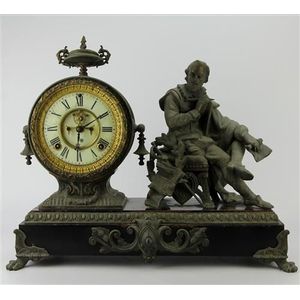Inlaid Slate Mantle Clock with Griffin Handles
You must be a subscriber, and be logged in to view price and dealer details.
Subscribe Now to view actual auction price for this item
When you subscribe, you have the option of setting the currency in which to display prices to $Au, $US, $NZ or Stg.
- Lion's Paw - The decorative lion's paw has been used in furniture, silver, and ceramics for centuries. It is a stylized representation of the paw of a lion, often depicted in a highly realistic or stylized form.
In furniture design, lion's paws were popular in the neoclassical and Empire styles of the late 18th and early 19th centuries. They were often used as feet on tables, chairs, and other pieces of furniture. The lion's paw was a popular motif for furniture makers because it added a sense of grandeur and regalness to their pieces.
In silverware design, the lion's paw was often used on the feet of tea and coffee pots, as well as on other pieces of silverware such as wine coolers and tureens. The lion's paw was often used in combination with other neoclassical motifs, such as acanthus leaves or grape clusters, to create a sense of grandeur and classical elegance.
In ceramics, lion's paws were commonly used as feet on vases, urns, and other pottery items. The lion's paw was often depicted in relief or as a highly stylized form, and was sometimes used in combination with other decorative elements, such as garlands or swags. - Griffin / Griffon / Gryphon - A griffin, also known as a griffon or gryphon, is a mythical creature with the body of a lion and the head of an eagle. It is typically depicted as a powerful and majestic beast, with the body and legs of a lion and the head, wings, and talons of an eagle. The griffin is widely recognized as a symbol of strength, courage, and guardianship, and has been used in a variety of cultures throughout history.
In ancient mythology, the griffin was often associated with the gods and was considered a symbol of divine power. In ancient Greece, for example, the griffin was associated with the sun god Helios, while in ancient Egypt, it was associated with the goddess Hathor. In medieval European heraldry, the griffin was used as a symbol of strength, valour, and protection, and was often featured on the coats of arms of noble families.
This item has been included into following indexes:
- Ansonia (United States) - clocks, maker or retailer 316
-
clocks, material or decoration
- marble or slate 425
- slate 344
Visually similar items

Ansonia Mercury spelter figural mantle clock, with open escapement porcelain dial, 45 cm width, 37 cm height approx, key and pendulum included

Antique French black and rouge marble clock, with lion masked head handles to sides surmounted with an urn, has key and pendulum, approx 37 cm high, 28 cm wide, 17 cm deep

Antique Ansonia Shakespeare mantle clock, with 8 day striking movement, visible escapement, enamel dial and figural ormolu case, key and pendulum included, working when tested, 46 cm wide, 19 cm deep, 34 cm high

Ansonia MacBeth spelter figural mantle clock on a timber base with claw feet, with a key & pendulum. Condition, good to fair, some wear, needs a service. Length 45 cm
